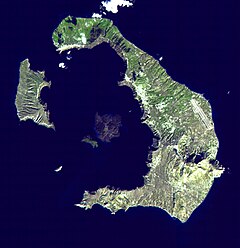| Minoan eruption of Thera | |
|---|---|
 | |
| Volcano | Thera |
| Date | c. 1600 BCE (see below) |
| Type | Ultra Plinian |
| Location | Santorini, Cyclades, Aegean Sea 36°24′36″N 25°24′00″E / 36.41000°N 25.40000°E |
| VEI | 7[1] |
| Impact | Devastated the Minoan settlements of Akrotiri, the island of Thera, communities and agricultural areas on nearby islands, and the coast of Crete with related earthquakes and tsunamis. |
The Minoan eruption was a catastrophic volcanic eruption that devastated the Aegean island of Thera (also called Santorini) circa 1600 BCE.[2][3] It destroyed the Minoan settlement at Akrotiri, as well as communities and agricultural areas on nearby islands and the coast of Crete with subsequent earthquakes and paleotsunamis.[4] With a Volcanic Explosivity Index (VEI) of 7, it resulted in the ejection of approximately 28–41 km3 (6.7–9.8 cu mi) of dense-rock equivalent (DRE),[5][1] the eruption was one of the largest volcanic events in human history.[6][7][8] Since tephra from the Minoan eruption serves as a marker horizon in nearly all archaeological sites in the Eastern Mediterranean,[9] its precise date is of high importance and has been fiercely debated among archaeologists and volcanologists for decades,[10][11] without coming to a definite conclusion.
Although there are no clear ancient records of the eruption, its plume and volcanic lightning may have been described in the Egyptian Tempest Stele.[12] The Chinese Bamboo Annals reported unusual yellow skies and summer frost at the beginning of the Shang dynasty, which may have been a consequence of volcanic winter (similar to 1816, the Year Without a Summer, after the 1815 eruption of Mount Tambora).[13]
- ^ a b Karstens, Jens; Preine, Jonas; Crutchley, Gareth J.; Kutterolf, Steffen; van der Bilt, Willem G. M.; Hooft, Emilie E. E.; Druitt, Timothy H.; Schmid, Florian; Cederstrøm, Jan Magne; Hübscher, Christian; Nomikou, Paraskevi; Carey, Steven; Kühn, Michel; Elger, Judith; Berndt, Christian (2023-04-29). "Revised Minoan eruption volume as benchmark for large volcanic eruptions". Nature Communications. 14 (1): 2497. Bibcode:2023NatCo..14.2497K. doi:10.1038/s41467-023-38176-3. ISSN 2041-1723. PMC 10148807. PMID 37120623.
- ^ Hardy DA (1989). "Therea and the Aegean World III", Volume III—Chronology (Proceedings of the Third International Congress, Hardy DA, editor). Retrieved 2008-03-16.
- ^ Paris, Raphael, et al., (2022). "A Minoan and a Neolithic tsunami recorded in coastal sediments of Ios Island, Aegean Sea, Greece", in: Marine Geology, Volume 452, October 2022, Abstract: "...tsunami deposits on the coasts of Ios Island, Aegean Sea, Greece...marine sediments and pumices from the ~1600 BCE Minoan eruption of Santorini volcano. This is the first evidence of the Minoan tsunami in the Cycladic Islands North of Santorini."
- ^ Antonopoulos, J. (1992). "The great Minoan eruption of Thera volcano and the ensuing tsunami in the Greek Archipelago". Natural Hazards. 5 (2): 153–68. Bibcode:1992NatHa...5..153A. doi:10.1007/BF00127003. S2CID 129836887.
- ^ Karstens, J.; Preine, J.; Crutchley, G.J.; Kutterolf, S.; van der Bilt, W.; Hooft, E.; Druitt, T.H.; Schmid, F.; Cederstrøm, J.M.; Hübscher, C.; Nomikou, P.; Carey, S.; Kühn, M.; Elger, J.; Berndt, C. (2022). "Revising the volume of the Minoan eruption (Santorini) based on new marine geophysical and sedimentological data" (PDF). 11th Conference Cities on Volcanoes (COV11).
- ^ Oppenheimer, Clive (2003). "Climatic, environmental and human consequences of the largest known historic eruption: Tambora volcano (Indonesia) 1815". Progress in Physical Geography. 27 (2): 230–59. Bibcode:2003PrPG...27..230O. doi:10.1191/0309133303pp379ra. S2CID 131663534.
- ^ McCoy, FW, & Dunn, SE (2002). "Modelling the Climatic Effects of the LBA Eruption of Thera: New Calculations of Tephra Volumes May Suggest a Significantly Larger Eruption than Previously Reported" (PDF). Chapman Conference on Volcanism and the Earth's Atmosphere. Thera, Greece: American Geographical Union. Retrieved 2007-05-29.
{{cite conference}}: CS1 maint: multiple names: authors list (link) - ^ Sigurdsson H, Carey, S, Alexandri M, Vougioukalakis G, Croff K, Roman C, Sakellariou D, Anagnostou C, Rousakis G, Ioakim C, Gogou A, Ballas D, Misaridis T, & Nomikou P (2006). "Marine Investigations of Greece's Santorini Volcanic Field". Eos. 87 (34): 337–48. Bibcode:2006EOSTr..87..337S. doi:10.1029/2006EO340001.
{{cite journal}}: CS1 maint: multiple names: authors list (link) - ^ Friedrich, Walter L. (2013). "The Minoan Eruption of Santorini around 1613 B. C. and its consequences" (PDF). Tagungen des Landesmuseums für Vorgeschichte Halle. 9: 37–48. ISSN 1867-4402.
- ^ Aitken, M. J. (1988). "The Thera Eruption: Continuing Discussion of the Dating". archaeometry. 30 (1): 165–182. doi:10.1111/j.1475-4754.1988.tb00444.x.
- ^ Kutschera, Walter (2020). "On the enigma of dating the Minoan eruption of Santorini". PNAS. 117 (16): 8677–8679. Bibcode:2020PNAS..117.8677K. doi:10.1073/pnas.2004243117. PMC 7183194. PMID 32291333.
- ^ Foster, Karen Polinger; et al. (1996). "Texts, Storms, and the Thera Eruption". Journal of Near Eastern Studies. 55 (1): 1–14. doi:10.1086/373781. S2CID 162024484.
- ^ Pang, K. D.; et al. (1989). "Climatic and Hydrologic Extremes in Early Chinese History: Possible Causes and Dates". Eos. 70: 1095.
